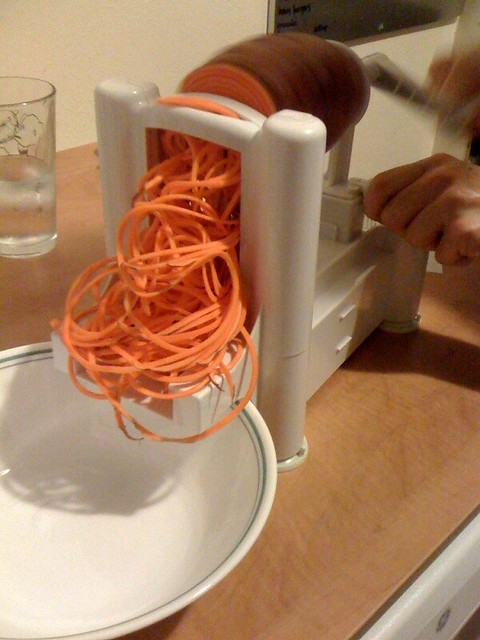
You’ll be happy to know that minimum gadgetry is required for a healthy, vegan, whole food plant-based diet!
You can get along absolutely fine with just the basic equipment – pots, pans, sieve, knives, oven etc.
Yet…

…once you foray into the online world of healthy, plant-based eating, you’ll come across pictures of spirilisers, dehydrators, and…wait for it…. the God of gadgets – the Holy Vitamix.

Look, if you’re a gadget freak, go get them. There are worse things to spend money on, and it might be fun experimenting. And if you have kids, I don’t doubt they’ll love spiralising tons of stuff, (though courgette/zucchini spaghetti just tastes like really damp spaghetti to me).
To be perfectly honest, if I had the cash flow and the will to sit down and order a Vitamix (and the space in my kitchen to store it!), well, yeah, I’d probably get one.

BUT my point is, you don’t NEED any of this. So if you are thinking of moving in a plant-based direction, and feel a bit intimidated by beautiful pics of spiralised this, dehydrated that, and think that you’re gonna have to throw the entire contents of your fruit bowl and vegetable drawer in the Vitamix every day – relax.
It’s often the raw crowd that use this stuff (see my post on why it’s not necessary to be raw to achieve optimal health). Be careful not to get vegan/plant-based mixed up with raw. Cooked grains and beans need to be a big part of a health-oriented diet for most of us, and all you need for these is pots and pans and a stove-top.
A whole food plant-based diet is eating about as close to nature as it gets. I don’t think any ancient civilisation, or any community known for longevity and health was in the habit of spiralising zucchini. And if they needed anything dehydrated, it was probably left out in the sun.
We really only ever need containers that hold the food while it’s being prepared, and stuff to poke it with while it’s cooking. The rest could actually be improvised if needed! Though let’s face it, it’s helpful to have knives, measuring cups and spoons, a sieve, a colendar etc.
However…
There is ONE, itty-bitty gadget that I DO endorse (not for dosh, unfortch!!), and that is the Magic Bullet, or it’s cheaper, yet identical cousin, the Hinari Genie.
This is mainly because of the benefits of including flax seeds in your daily diet (as detailed here).

Some seeds are so small it’s difficult to break them down sufficiently enough between our teeth to get the maximum benefit from the goodness they have inside, and many will just get digested whole. Blitzing them with ‘the bullet’ makes them a lot easier to eat and ingest.
Many years ago, pre-Magic Bullet, I used to crush two tablespoons of flax seeds every morning with a pestle and mortar.
This took frickin’ ages. Ages I didn’t have. And my hand was permanently sore from the job – flax seeds are tough little muthas to crush.
Some people recommend coffee-grinders, but these are more expensive, and you would need a dedicated one for seeds – if you used it for coffee too it would leave a taste.
I can’t even remember how I got the notion to try a Magic Bullet but it ranks as one of the best notions I’ve ever had. It blitzes flax in an instant.
As I’m doing the flax anyway, I’ll sometimes throw in a couple of teaspoons of sesame, pumpkin or sunflower seeds. And not that I often use them but I bet it would blitz hemp and chia seeds amazingly as well.
I don’t throw nuts in there because they don’t blitz very well. They contain oil and won’t completely break down in a Magic Bullet – but nuts are big enough to bite and chew, so it’s better to eat them from their normal state, or roughly chopped.
If you think I’m missing a crucial gadget, let me know in the comments. And buy me one. Or maybe don’t! If I’ve lived this long without it, I don’t need it!


































































